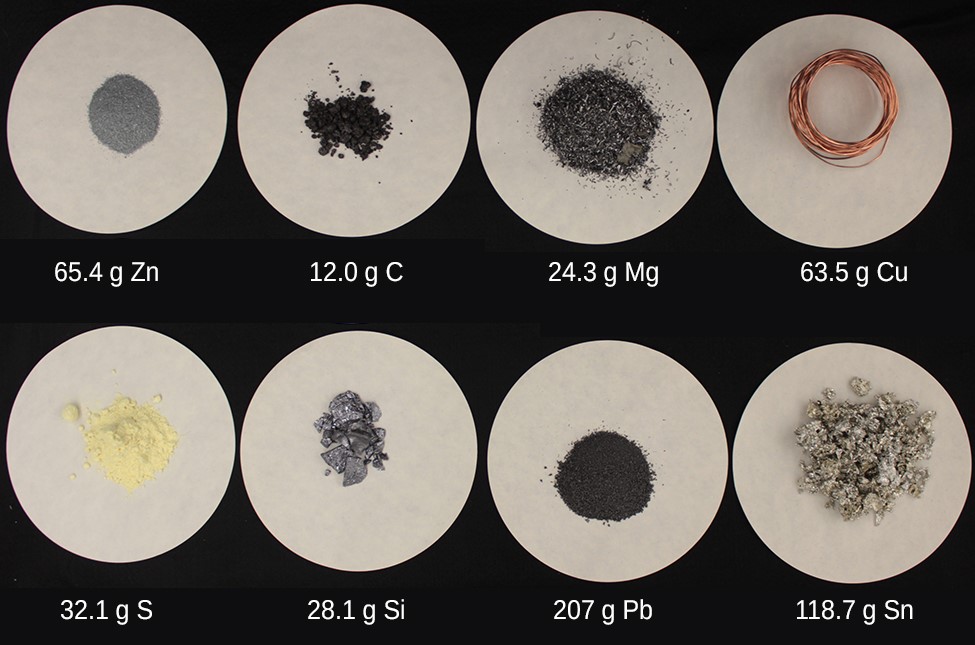7.1 The Mole Concept and Avogadro’s Number
Learning Objectives
By the end of this section, you will be able to:
- Define the amount unit mole and the related quantity Avogadro’s number
- Perform calculations between the mole and Avogadro’s number
The identity of an elemental substance is defined not only by the type of atom it contains, but also by the quantity of atoms in the sample. For example, a 1.00 g sample of iron (Fe) contains 1.08 x 1022 atoms of iron. (That is a lot of atoms! If we were to divide those atoms up amongst each of the 7.9 billion people on earth in 2021, each person would have more than a trillion atoms). Because real samples we use in the laboratory will always be composed of very large numbers of atoms, scientists regularly use a unit, the mole, to count the very large quantities.
The mole is an amount unit similar to familiar units like pair, dozen, gross, etc. It provides a specific measure of the number of atoms or molecules in a bulk sample of matter. By definition, a mole is the amount of a substance containing the same number of atoms as the number of atoms in a sample of pure 12C weighing exactly 12 g. One Latin connotation for the word “mole” is “large mass” or “bulk,” which is consistent with its use as the name for this unit. The mole provides a link between an easily measured macroscopic property, bulk mass, and the number of atoms present in a sample.
The number of entities composing a mole has been experimentally determined to be 6.02214179 × 1023, a fundamental constant named Avogadro’s number (NA) or the Avogadro constant in honor of Italian scientist Amedeo Avogadro. For atoms, this constant is properly reported with an explicit unit of “per mole,” a conveniently rounded version being 6.022 × 1023 atoms/mol.
6.022 x 1023 atoms = 1 mole of atoms
Consistent with its definition as an amount unit, 1 mole of any element contains the same number of atoms as 1 mole of any other element. The masses of 1 mole of different elements, however, are different, since the masses of the individual atoms are drastically different. The molar mass of an element is the mass in grams of 1 mole of that substance, a property expressed in units of grams per mole (g/mol) (see Figure 7.1a).

Because the definitions of both the mole and the atomic mass unit are based on the same reference substance, 12C, the molar mass of any substance is numerically equivalent to its atomic or formula weight in amu. Per the amu definition, a single 12C atom weighs 12 amu (its atomic mass is 12 amu). According to the definition of the mole, 12 g of 12C contains 1 mole of 12C atoms (its molar mass is 12 g/mol). This relationship holds for all elements, since their atomic masses are measured relative to that of the amu-reference substance, 12C. We can see this applied to several elements in Table 7.1a. While the numerical values are the same, the different units help us to remember whether we are describing the mass of a single atom or the mass of a very large number of atoms.
| Element | Mass of a single atom | Mass of 6.022 x 1023 atoms |
|---|---|---|
| argon (Ar) | 39.95 amu/atom | 39.95 g/mol |
| iron (Fe) | 55.85 amu/atom | 55.85 g/mol |
| selenium (Se) | 78.96 amu/atom | 78.96 g/mol |
Watch How Big is a Mole (4:33 min)
Video source: TED-Ed. (2012, September 11). How big is a mole? (Not the animal, the other one.) – Daniel Dulek [Video]. YouTube.
The relationships atomic mass, the mole, and Avogadro’s number can be applied to compute various quantities that describe the composition of an elemental substance. In this section, we will look at how the mole and Avogadro’s Number can be related. The following expression can be used to express the relationship between the number of moles and Avogadro’s Number:
Example 7.1a
How many atoms are in 3.5 moles of iron, Fe?
Approach
Convert the moles of Fe to the number of atoms using Avogadro’s number.
Solution
Number of atoms = Amount of moles x Avogadro’s number
Number of atoms = 3.5 mol x 6.022 x 1023 atoms/mol
Number of atoms = 2.1 x 1024 atoms of Fe
Source: Adrienne Richards is licensed under CC BY NC 4.0.
Exercise 7.1a
How many atoms are present in 1.8 moles of Sodium, Na?
Check Your Answer[1]
Source: “Exercise 7.1a” by Adrienne Richards is licensed under CC BY-NC 4.0.
Example 7.1b
How many moles are present in 2.60 x 1021 atoms of Copper, Cu?
Approach
Convert the number of atoms to moles of Cu using Avogadro’s number.
Solution
Amount of moles = Number of atoms / Avogadro’s number
Amount of moles = 2.60 x 1021 atoms / 6.022 x 1023 atoms/mol
Amount of moles = 0.0043 moles of Cu
Source: “Example 7.1b” by Adrienne Richards is licensed under CC BY-NC 4.0.
Exercise 7.1b
How many moles are present in 1.80 x 1022 atoms of Silver, Ag?
Check Your Answer[2]
Source: “Exercise 7.1b” by Adrienne Richards is licensed under CC BY-NC 4.0.
Links to Interactive Learning Tools
Practice Mole Conversions by the Physics Classroom.
Key Equations
Number of atoms/molecules/ions = n x NA
Attribution & References
the amount of a substance containing the same number of atoms as the number of atoms in a sample of pure 12C weighing exactly 12 g
experimentally determined value of the number of entities comprising 1 mole of substance, equal to 6.022 × 1023 mol−1
the mass in grams of 1 mole of that substance

